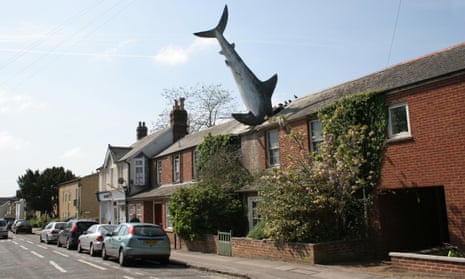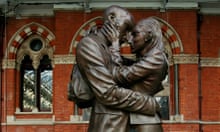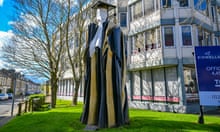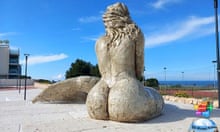One April evening in 1986, Bill Heine was sitting on the steps opposite his newly purchased terraced house in Oxford, drinking a glass of wine, when he turned to his friend and asked a simple question: “Can you do something to liven it up?”
His friend, the sculptor John Buckley, provided an answer in the shape of an eight-metre (25ft) shark which would sit on his roof, perpetually appearing as though it had just crashed into the house from the sky. The fibreglass fish, which became known as the Headington Shark after the Oxford suburb, led Heine, a local journalist and businessman who died last week, into a six-year legal battle with the local council.
The process turned a relatively unremarkable street into a beloved local landmark and resulted in one of the most notable triumphs of British eccentricity over petty bureaucracy.
“You could see the Americans were taking off from Heyford outside of Oxford to bomb Gaddafi in Libya,” Buckley said. Both Buckley and Heine wanted to make a powerful statement about the barbarity of war and the feeling of vulnerability and utter helplessness when disaster struck.
Heine also really liked sharks, Buckley added.
The connection with war was more vague. Buckley said he was once forced to swim through shark-infested waters after he broke a canoe in Mexico. “I was expecting the bomb to come out of the water. I was ready for the big bite. It’s just as bad as looking up at the sky and expecting something to come through your roof,” he said.
The artist started on the work immediately after his discussion with Heine. He worked with a group of volunteers – largely students and other anti-war activists – to build an artificial roof to hold the shark outside his studio. He didn’t tell any of them where he planned to put the sculpture. It took exactly three months and by Saturday 9 August, at 5am, Buckley was moving the shark sculpture into a position on a tractor trailer. There was a large crane waiting at Heine’s house.

“The crane just dropped it straight in and it went in beautifully as the postman was passing,” Buckley said. “That first morning was amazing. By Sunday, it was worldwide and its been like that for 30-odd years.”
Oxford city council immediately opposed the installation of the shark. At first, they said it was dangerous to the public, but engineers and inspectors pronounced it structurally safe.
Heine, an American who moved to the UK to study at Oxford University in the 1960s, then submitted a planning application, which was rejected by the council. He appealed to the environment secretary, then Michael Heseltine.
The council held public forums allowing residents to speak in favour of or against the sculpture. Patrick Gray, now 71, an economist who lived his whole life in Oxford, was one of the many to speak in favour: “People only ever heard of it because the planning committee took this ridiculous decision to get it removed,” Gray said. “An inspector came down and had a public hearing. I made a little speech against what I felt was municipal preposterousness.”
Bill Dufton, the former director of Southern Arts, whose regional arts council office was based in Winchester, said: “It was our policy to support public art work of many kinds. This must have been one of the most striking.”
Others came from further afield to defend the art. Peter Bibby, 70, travelled from London to speak in favour of the sculpture at a hearing. “The council were saying there is no historical or artistic value to it, that it’s no different from a hamburger sign at Christ Church College,” Bibby said. “I said it was of artistic value, it doesn’t matter if you approve of the art or not.”
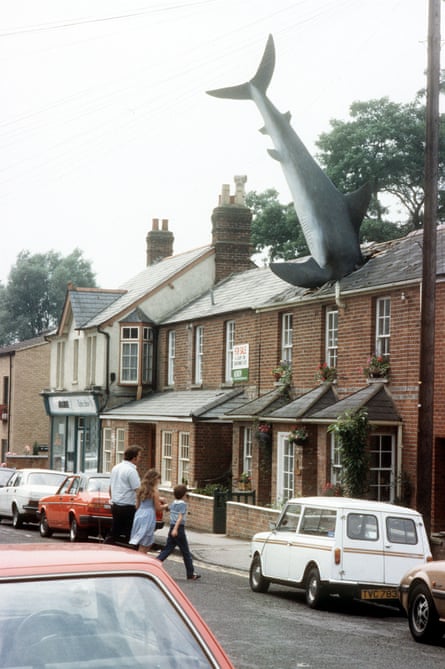
Heseltine’s planning inspector, Peter Macdonald, investigated and ultimately came out in favour of keeping the sculpture, with an official ruling that has gained legendary status among town planners for its defence of art.
“In this case it is not in dispute that the shark is not in harmony with its surroundings, but then it is not intended to be in harmony with them,” wrote Macdonald in his official ruling.
“The council is understandably concerned about precedent here. The first concern is simple: proliferation with sharks (and heaven knows what else) crashing through roofs all over the city. This fear is exaggerated. In the five years since the shark was erected, no other examples have occurred … any system of control must make some small place for the dynamic, the unexpected, the downright quirky. I therefore recommend that the Headington Shark be allowed to remain.”
A few years ago, it was reported that the shark was at risk of being removed and the the bank was threatening to repossess the property. Heine’s son Magnus stepped in and bought the property to make sure the well-loved shark was not destroyed by “another set of bureaucrats unable to deal with something that wouldn’t fit a standardised form”.
After Heine died of cancer, aged 74, last week, tributes came flooding in from many locals, including city councillors.
Gray described Heine as a “colourful character” who inspired people. He said: “We once had a 12-year-old boy visit from America. He was miserable and unhappy when he arrived, so we took him to see the house. He left with a very big smile on his face.”
